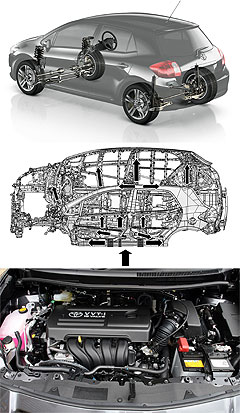Make / Model Search
News - Toyota - CorollaHeavy duty CorollaBattle of the bulge: New Corolla has stacked on the pounds. Higher safety and SUV underpinnings have added considerable weight to the new Toyota23 May 2007 LARGER and heavier engine options, all-wheel drive adaptability, increased crash safety, better body rigidity and higher equipment levels are the reasons behind the new-generation Corolla's unexpected weight increase. With some models more than 200kg heavier than before, Toyota's one-time lightweight now has a higher kerb weight than most equivalently-specified rivals, including the Honda Civic, Mazda3 and Volkswagen Golf. According to the 10th-generation Corolla's executive chief engineer, Soichiro Okudaira, much of the floorpan is shared with the third-generation RAV4 compact SUV. As a consequence, extra bracing in the new Corolla's engine bay and floor structure was necessary for the four-cylinder diesels and V6 petrol engines that the RAV4 offers in some other markets worldwide. Both these powerplants are significantly heavier than the four-cylinder petrol engines that Australians traditionally associate with small cars like the Corolla. Their extra torque outputs add stress to items such as engine mounts, as well as increased NVH (noise, vibration and harshness) issues, necessitating extra measures – expressly, more sound deadening – to be taken for these to be quelled. Mr Okudaira pointed out that to house the all-wheel drive hardware in the RAV4, as well as the Japan-only AWD Corolla/Auris models, the rear floor section also needed strengthened. In turn, the Corolla's more sophisticated double wishbone suspension – which usurps the simpler, cheaper and more space-efficient torsion beam arrangement that all Australian-bound models have – was devised especially to accommodate the AWD hardware. The upshot for Toyota is that the more powerful diesel and upcoming sporty versions of the Auris and Corolla use the double wishbone rear suspension to help improve dynamics and control. This also gives the Corolla a useful dynamics and marketing heads-up in Europe, where only a handful of rivals, namely the Golf (and its Audi, Seat and Skoda spawns), Ford Focus and Mazda3 can boast of such sophisticated underpinnings. All these factors, combined with the more obvious reasons, go some way towards explaining why the latest Corolla is heavier.  From top: Multi-link suspension, side-impact absorbing structure and Corolla VVT-i engine (bottom). From top: Multi-link suspension, side-impact absorbing structure and Corolla VVT-i engine (bottom).These include the need to meet current and coming safety legislation with stronger bodies, improved platform rigidity, and more safety technologies such as stability control and extra airbags. Compared to the previous model, extra bracing exists in the Corolla's roof, floor and front suspension tower, with the transmission tunnel gaining more strength, the triangular A-pillars adding extra rigidity, and two chassis rails instead of one being employed. The latest Corolla also introduces new-to-series equipment upgrades that stack on the kilos above and beyond the extra safety features, such as keyless entry and ignition, high intensity discharge (HID) headlights and Bluetooth communication devices. Although Toyota acknowledges that some Corolla models are up to 20 per cent heavier than before, it claims that the body-in-white weight gain is only in the region of 50kg. Toyota also defends the added kilos by pointing out the minimal fuel consumption increases – as well as some economy gains depending on the model – that the latest Corolla offers, as a result of greater mechanical efficiencies and advancements in aerodynamics. Interestingly, the previous 120-series Corolla also shared its front-wheel drive platform with the second-generation RAV4, as well as the last Celica sportscar. However, according to one Toyota insider, the need to accommodate the latter's lightweight sportscar performance and dynamic abilities were the priorities back in the late 1990s, when this platform was being devised. The last Celica's dismal sales performance, as well as the inexorable rise of the SUV around the world, has shifted Toyota's attention away from saving weight this time around. At that time, Toyota did not concentrate as highly on passenger-car diesel engine development, either. However, skyrocketing fuel prices and the desire to sell more vehicles in diesel-mad Europe mean that all future non-Japanese market Toyotas must be able to accommodate diesels. It is unlikely that Australians will see diesel-powered Corollas in this generation edition. Read more:First drive: All-new Corolla steps up a gradeRead Toyota Corolla range drive impressions Corolla cracks $20K Corolla V6 on the cards |
Click to shareToyota articlesResearch Toyota Corolla pricing
Motor industry news |









Facebook Twitter Instagram